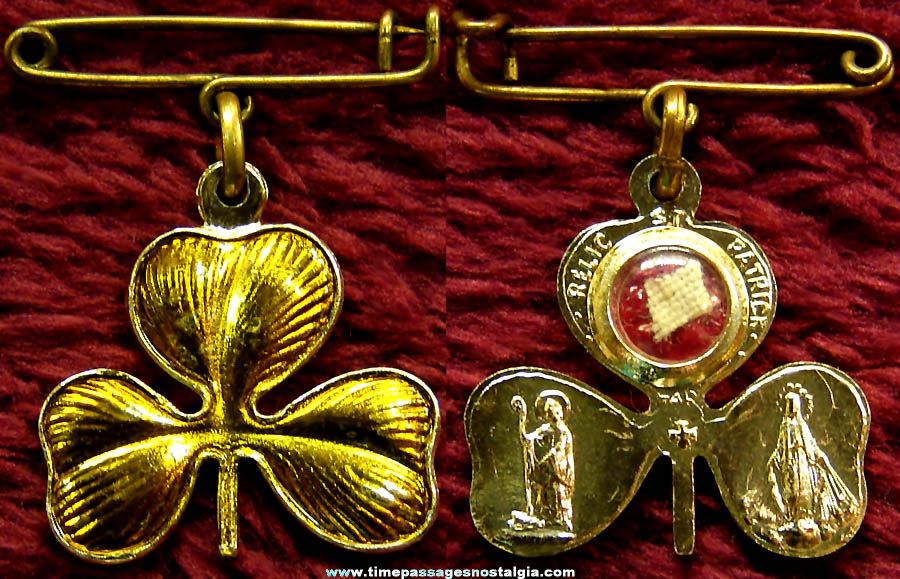
   | | Any group of items being offered as a lot must be sold as a lot. | | | | Unique & Fun Nostalgic Items | You don't have to be an eight year old to enjoy having
a childhood treasure. | | An Ever Changing Inventory | You can feel secure
shopping with PayPal. | Nostalgic Memorabilia, Pop Culture Artifacts, Historic Items,
and "Shoe Box Toys" | Whether you've collected Memorabilia for years or just want to feel like a kid again, please take a few moments to browse through what we
have available for sale. | All Original Items.
No Reproductions | Don't forget to
bookmark this site. |
| | | | The picture below shows a larger front and back view of this Old St. Patrick Jewelry Pin with Hanging Clover Religious Relic Charm. The pin and charm are not dated and the year that it was made is unknown. It is not marked and the maker is also unknown. The pin at the top is made of brass. The three leaf clover charm is metal with one side gold colored and the other side silver in color. The charm has religious images of we believe St. Patrick and the Virgin Mary. At the top of the charm is a tiny encased piece of white cloth with a red background. There is a tiny cross in the center and it is marked as follows: RELIC
ST. PATRICK
ITALY The pin, with the hanging relic charm measures about 7/8'' x 1-1/8''. It appears to be in mint condition as pictured. Below here, for reference, is some additional information on Saint Patrick: Saint Patrick
From Wikipedia, the free encyclopedia Born: Great Britain
Venerated in: Catholic Church, Eastern Catholic Churches, Eastern Orthodox Church, Anglicanism, Lutheranism
Major shrine: Armagh, Northern Ireland, Glastonbury Abbey, England
Feast: 17 March (Saint Patrick's Day)
Patronage: Ireland, Nigeria, Montserrat, Archdiocese of New York, Roman Catholic Archdiocese of Newark, Boston, Rolla, Missouri (USA), Loíza, Puerto Rico, Murcia (Spain), engineers, paralegals, Archdiocese of Melbourne; invoked against snakesSaint Patrick was a 5th century Romano British Christian missionary and bishop in Ireland. Known as the ''Apostle of Ireland'', he is the primary patron saint of Ireland, along with Saints Brigit and Columba. He is also venerated in the Orthodox Church as Equal to the Apostles. The dates of Patrick's life cannot be fixed with certainty but, on a widespread interpretation, he was active as a missionary in Ireland during the second half of the fifth century. He is generally credited with being the first bishop of Armagh, Primate of Ireland. According to the Confessio of Patrick, when he was about 16, he was captured by Irish pirates from his home in Great Britain, and taken as a slave to Ireland, looking after animals, where he lived for six years before escaping and returning to his family. After becoming a cleric, he returned to northern and western Ireland. In later life, he served as an ordained bishop, but little is known about the places where he worked. By the seventh century, he had already come to be revered as the Patron Saint of Ireland. Saint Patrick's Day is observed on 17 March, which is said to be the date of his death. It is celebrated inside and outside Ireland as a religious and cultural holiday. In the dioceses of Ireland, it is both a solemnity and a holy day of obligation; it is also a celebration of Ireland itself. |
|
Click on image to zoom.
 |